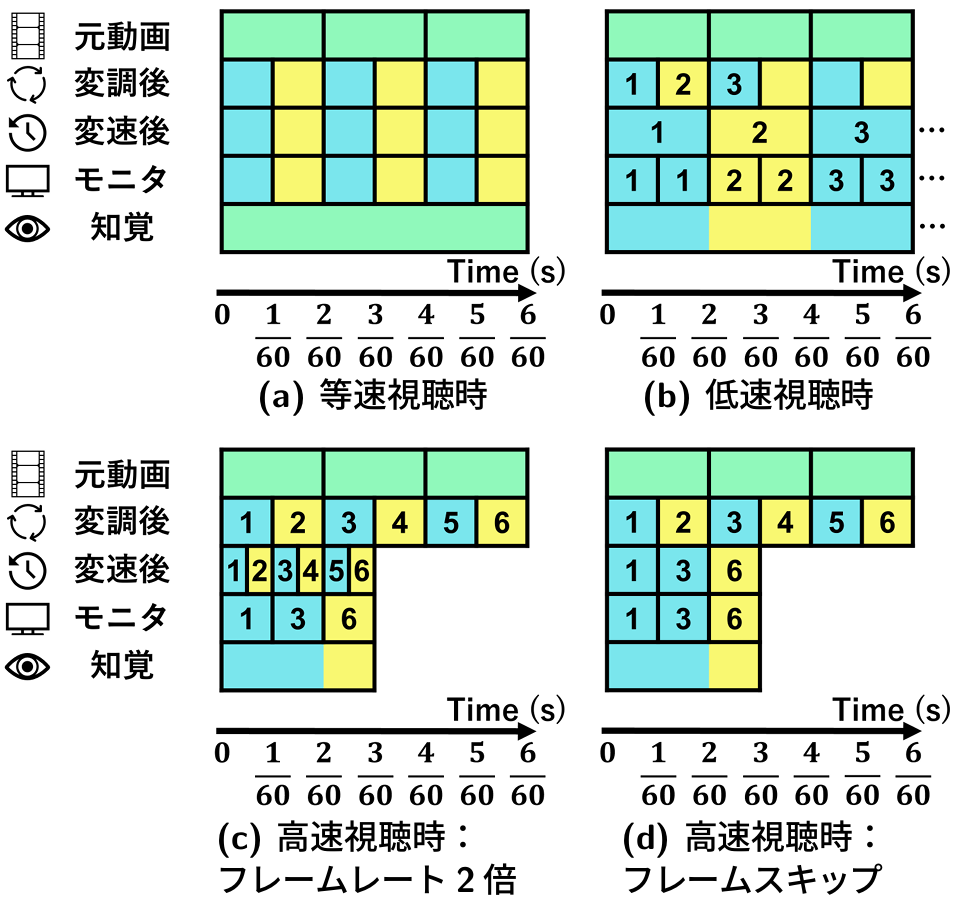Summary
Watching videos has become a part of our daily lives, and more and more people are changing the watching speed. But does changing the watching speed always have positive effects?
In this study, we show a method that deliberately inhibits changes in watching speed. By ensuring that videos can only be watched at their original tempo, we aim to achieve better communication.
Example
Here is an example of applying our method to «Cmainandes 3: Llamingos» (CC BY 4.0).
・Video quality set to 720p60 or 1080p60
・60 Hz monitor settings
・Stable network connection
You should be able to observe changes in the appearance of the video depending on the watching speed.
Why do we inhibit changes in watching speed?
Previous studies in the field of education have already shown that watching speed has little effect on the semantic understanding of videos. So why do we inhibit changes in watching speed?
The reason for inhibiting changes in watching speed can be explained by considering the artistic nature of videos.
The linguist Jakobson analyzed the concept of “poetry” by breaking down communication into six factors and their corresponding functions.

Among these, the poetic function focuses not on the meaning of the message but on its form, making communication an artistic expression. Since changes in watching speed directly alter the form of a message—such as its tempo and pauses—this function is likely to be the most affected.
Studies in the field of education have not considered the impact on the poetic function. Could preventing changes in watching speed contribute to preserving the artistic nature of videos?
A method of inhibition utilizing color vibration
In this study, we inhibit changes in watching speed visually by utilizing color vibration.
Color vibration refers to the rapid switching of colors with constant luminance but varying chroma. It is known that humans perceive these rapidly switching colors as an intermediate color. This phenomenon has primarily been studied in the field of visible light communication. In this study, similar to those studies, we divide each frame of the video into two perceptually equivalent frames, enabling changes in appearance according to watching speed.
The following figure illustrates the changes in appearance corresponding to watching speed. When the watching speed is changed, the color switching slows down, making it perceptible to the human eye, and thereby altering the appearance of the video. Particularly when watching at high speed, this is made possible by causing a kind of temporal aliasing. For more detailed information on the working principles, please refer to the presentation manuscript.

As described above, this research does not develop a video platform, but rather takes an approach that modifies the video itself. This allows the content creator, rather than a third party, to directly inhibit changes in watching speed, and also increasing the flexibility of the watching environment.
Members
| Name | Affiliation | Web site |
|---|---|---|
| Keio University | ||
| Renshu Gu | Hangzhou Dianzi University |
Publications
Presentation
Unrefereed
- Daiki Kitayama, Renshu Gu, Issei Fujishiro: “Proposal and evaluation of videos that inhibit changes in watching speed utilizing color vibration,” in Proceedings of Expressive Japan 2025 (The Institute of Image Information and Television Engineers Technical Report, Vol. 49, No. 10, pp. 401–404, AIT2025-155), Tokyo Polytechnic University, March 10, 2025, Excellent poster awards (in Japanese).
- Daiki Kitayama, Renshu Gu, Issei Fujishiro: “A proposal of videos that inhibit changes in watching speed using color vibration,” in Proceedings of the 87th National Convention of International Processing Society of Japan, Vol. 1, pp. 535–536 (7N-06), The University of Ritsumeikan, March 15, 2025 (in Japanese).
Grants
 Grant-in-Aid for Challenging Research (Exploratory): 23K18468 (2023-)
Grant-in-Aid for Challenging Research (Exploratory): 23K18468 (2023-)